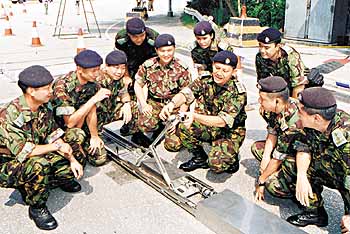Frontline minds combine
to tackle border crime

A run down on the camera's operation by SSP Sidney Fung
|
The technical skills and ingenuity of frontline officers, sometimes underrated by the public, have been highlighted with the launch of Border District's ingenious new illegal immigrant detection device.
Made of a series of pinhole cameras and sensors controlled by a microprocessor, the device can thoroughly scan the undercarriage of a lorry or semi-trailer for stowaway IIs hiding among the suspension and axle system.
One camera is mounted on a mechanical arm fitted to a moving platform allowing coverage of even the darkest nooks. The cameras are fitted with spotlights to illuminate the undercarriage and the device can run non-stop, conducting the inspection cycle every nine seconds.
Acting Border District Commander Sidney Fung Kwok-on assembled a team of officers from three Divisions with electronic, computer and mechanical experience to develop the project in May. Headed by Inspectors Shue Chi-yuen, a manufacturing and engineering graduate, and Stanley Wong Tsan-hung, a programmer and electronic engineer, the team made and tested several models in the following months, the trials seeing the eventual development of the finalised design.
"These goods vehicle stowaways have always been a problem for us as they change tactics to avoid detection. They account for about half of all illegal land crossings," Mr Fung said.
"More recently they have been hiding above axles, so I thought of a very simple design to allow us to detect them in these hidden areas, and assembled the project team. This device can cover all of the blind spots under a vehicle and this project shows that many problems can be solved if officers use their brains and have an innovative mind."
IP Shue said the three cameras took still images from different sections of the undercarriage, displayed on a computer monitor for officers to examine. He added that still pictures minimised the eye fatigue that could be caused by monitoring motion pictures.
IP Wong said the device had just gone into service at Lok Ma Chau and the project team would soon build two more for the Sha Tau Kok and Ta Kwu Ling checkpoints.
"What makes this device unique, is that it was made and designed by frontline officers at a very cost effective $30,000. Everything was done by us with a little assistance from Comms Branch and City University," he said.
"It would have been far more expensive to bring in someone from outside, and inefficient as they don't know our requirements. The project required a lot of testing and teamwork from BORDIST officers."
The Hong Kong Productivity Council agreed to help apply for a patent for the design, which was already gaining overseas media coverage.
|